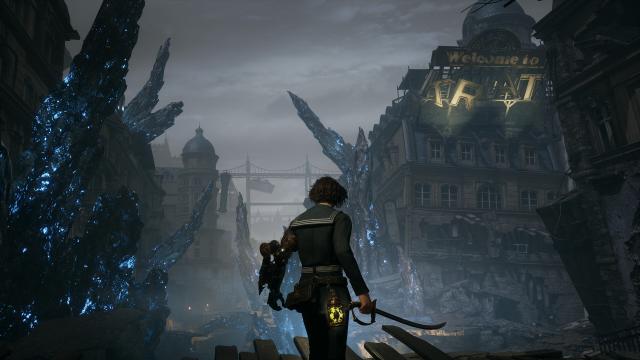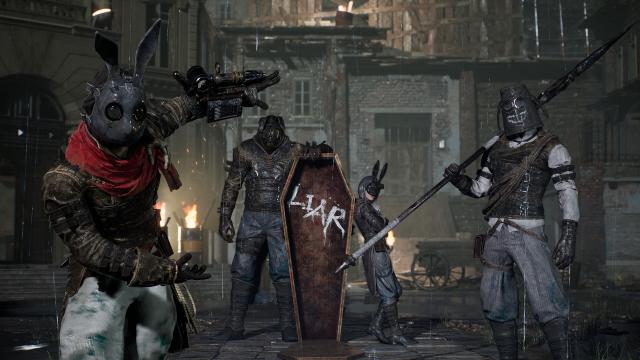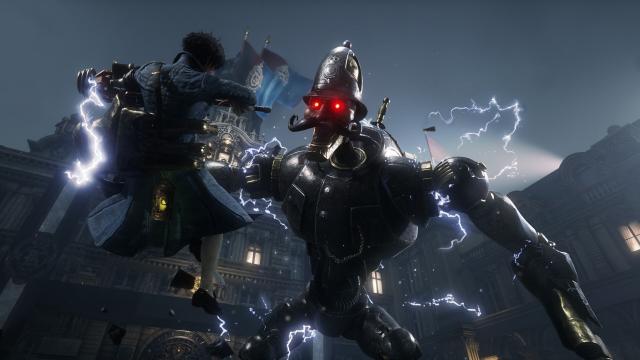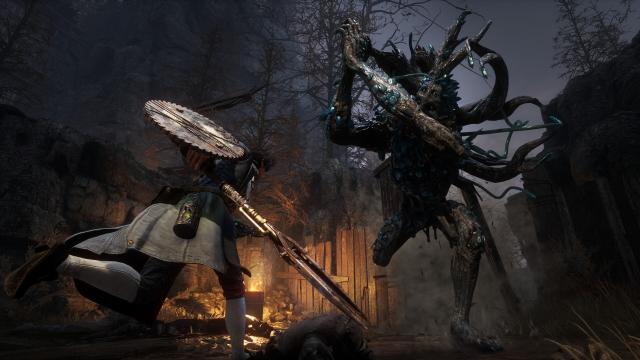Existing User Log In
New User Registration
Register for a free account to gain full access to the VGChartz Network and join our thriving community.





America - Front


America - Back

Neowiz Corporation
Role-Playing
 (Add Date)
(Add Date) (Add Date)
(Add Date) (Add Date)
(Add Date)
| Owners: | 0 |
| Favorite: | 0 |
| Tracked: | 0 |
| Wishlist: | 0 |
| Now Playing: | 0 |
To say that the success of Dark Souls led to the floodgates of a genre being opened would be an understatement. If Soulslikes haven’t yet surpassed Metroidvanias for the genre most saturating the market, they must surely be close. And, just like Metroidvanias, the sheer deluge of titles has made it very difficult for new releases to stand out. With many of the obvious Soulslike spin-offs having been done long ago, it takes a really unique title with a well-executed idea to stand out amidst the crowd.
Lies of P certainly checks off the unique box from a concept standpoint, being a spin on the story of Pinnochio. In this world, Pinnochio is still a puppet, but is a fully functional automatron capable of self-defense rather than the mischievous marionette he is in the fable. The city of Krat is overrun by militaristic, human-killing puppets, and Pinnochio is tasked with going out and saving as many survivors as he can.

As with the Soulsborne titles, the actual plot here is pretty barebones. NPCs are few and far between, and it’s rare that you’ll encounter any that provide more than a single dialogue choice. This is where the titular “lies” in Lies of P come into play: every so often, the player is presented with a choice on whether to tell the truth or to lie. It’s an interesting idea on its surface, but the game ultimately doesn’t do much with it. In fact, as far as I can tell, there’s only one story element that changes at all based on these choices, which I’m going to go ahead and spoil slightly here: make sure to lie every time. You’ll lock yourself out of the best ending if you don’t and you can always opt to pick another ending if you don’t want it for some reason.
The lore is where Lies of P picks up the slack on the story front, and basing itself on a fairy tale, it does a fantastic job of weaving together a unique spin on familiar elements. Along with the aforementioned changes to Pinnochio and the city of Krat, characters from the fable like Gepetto, Jiminy, and Sophia are all prominently featured with their own unique designs and roles to play in the background of the game’s events. As someone familiar with the story of Pinnochio, it was interesting to see these characters taken in new ways, oftentimes in directions I didn’t anticipate.

The core gameplay loop is pretty bog standard for a Soulslike at this point: you travel between checkpoints with a limited number of health refills, resting at checkpoints revives all enemies, killing enemies provides currency which can be used to level up but is also dropped upon death, and you run into at least one poison swamp and curse the day that Hidetaka Miyazaki first drew breath. So far, so Dark Souls. Where Lies of P starts to differentiate itself a bit is which Souls games it specifically tries to emulate the most closely, however.
Initial trailers for Lies of P drew comparisons to Bloodborne thanks to its aesthetic, but despite that I’d say the level design of Lies of P aligns more closely with Dark Souls III than anything else. Environments are fairly straight forward and don’t contain much in the way of branching paths outside of occasional shortcuts back to a checkpoint, and verticality is woven into a relatively straightforward path forward. It’s surprisingly hard to get lost in Lies of P, which isn’t necessarily a bad thing, but if you come into this expecting Bloodborne-esque non-linearity then you may find yourself somewhat disappointed.

If the level design feels like it takes inspiration from Dark Souls III, the combat has stolen Sekiro’s identification and is currently masquerading as it in Italy. Put another way, combat is the point where Lies of P goes from imitating From Software’s concept to tearing off its skin and wearing it around like a poncho. As with Sekiro, everything in Lies of P revolves around stamina, both for you and the enemy. Depleting an enemy’s stamina will provide the opportunity to deal a massively damaging attack, making the fight as much about managing the enemy’s stamina as it is about managing its health bar. You’ll constantly be asked to judge whether you should continue pushing the advantage to keep a tough enemy or boss from regaining stamina, or whether you should take a step back to heal and protect yourself.
As in Sekiro, defending yourself revolves heavily around parrying. Your character is equipped with a block and a dodge, neither of which are particularly good defensive options on the surface. The dodge doesn’t have many invulnerability frames and simply holding block will result in Pinnochio taking a sizable amount of chip damage. Instead, you're meant to press block just before the attack lands, which will negate chip damage and deplete a greater amount of enemy stamina than simply blocking.

I still maintain that I don’t feel this is a system that fits a Soulslike’s style of combat especially well. There’s nothing wrong with a parry mechanic, but Souls games are, I would argue, RPGs at heart; they're about designing a style of play and figuring out how to survive larger than life encounters with it. What a parry system like this tends to do is railroad the player into one specific way to fight bosses: die enough times to learn parry timings, memorize its attack patterns, and then execute. This is especially true for Lies of P, which has an extremely tight parry window and relies heavily on giving its bosses mixups and delays on their attacks, making battles feel more like slowly just memorizing the moveset of an individual foe rather than mastering the combat system. Compared to the inventive and unique selection of fights in something like Bloodborne or Dark Souls III, the fights in Sekiro and Lies of P all tend to blur together, which I think has a lot to do with how the player is tasked with approaching them.
Lies of P does have a few unique ideas that I think are pretty interesting. Weapon building is a solid concept that I think carries some of the RPG torch that is otherwise let down by the rather straightforward approach to combat. Almost every weapon in the game can be broken down into a blade and handle, and blades and handles can be mixed and matched. Blades contribute damage and speed stats, while handles contribute the actual moveset of the weapon, and you can create some really fun weapon combinations that are suited to particular situations if you feel like experimenting.

Additionally, that Bloodborne aesthetic which drew so much praise in the game’s trailers is certainly worthy of acclaim. Krat gives off a very oppressive atmosphere that, at its best, rivals even the Souls titles. The sound design pulls a lot of the game’s weight here, setting up an ambience that really gives the sense that you’re not wanted in Krat. The constant rainfall and the decrepit cityscape really sell the feel of a hellscape overrun by nightmares.
Before wrapping up, I would be remiss in not attaching a significant warning to Lies of P with regards to its difficulty, which I’m not sure I’ve ever done before and, if I have, it certainly isn’t something I’ve done frequently. Lies of P has some bosses that come with absolutely brutal difficulty spikes, to the point where I think first time players are really, really going to struggle without making use of the optional summoning mechanic. Part of me suspects that the game balanced its fights around the assumption that players would be summoning, which I’m not really a fan of if that’s the case. And if it’s not the case, then the preceding levels certainly don’t adequately prepare the player for the challenge presented by these bosses.

All of that is to say, Lies of P is a high intensity, high effort title that demands your full attention. If the prospect of a game with a very challenging combat system that will likely require dozens of attempts for most bosses as you slowly memorize every aspect of their movesets is appealing, then you'll probably feel right at home here. But to people who initially got excited about it because of the visual comparisons to Bloodborne, I’d say wait for a sale or pass entirely; this is probably not the game you think it will be.
You will probably like Lies of P if: The idea of "Sekiro, but requires more precision" is something that sounds enticing.
You might like Lies of P if: You enjoyed, but didn't love Sekiro.
You will probably not like Lies of P if: You're primarily interested in a Souls game based on the atmosphere and non-linear level design.









